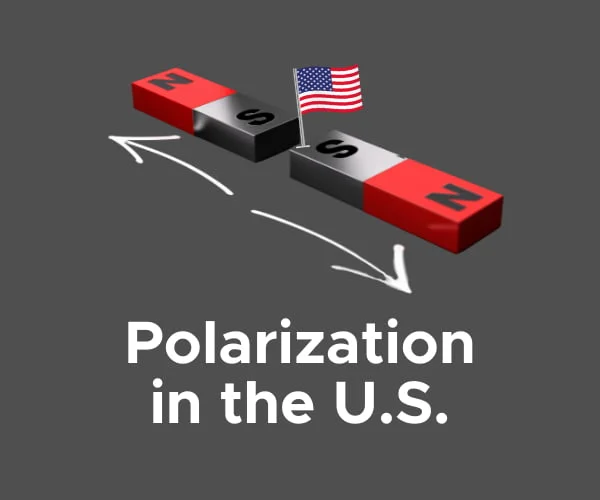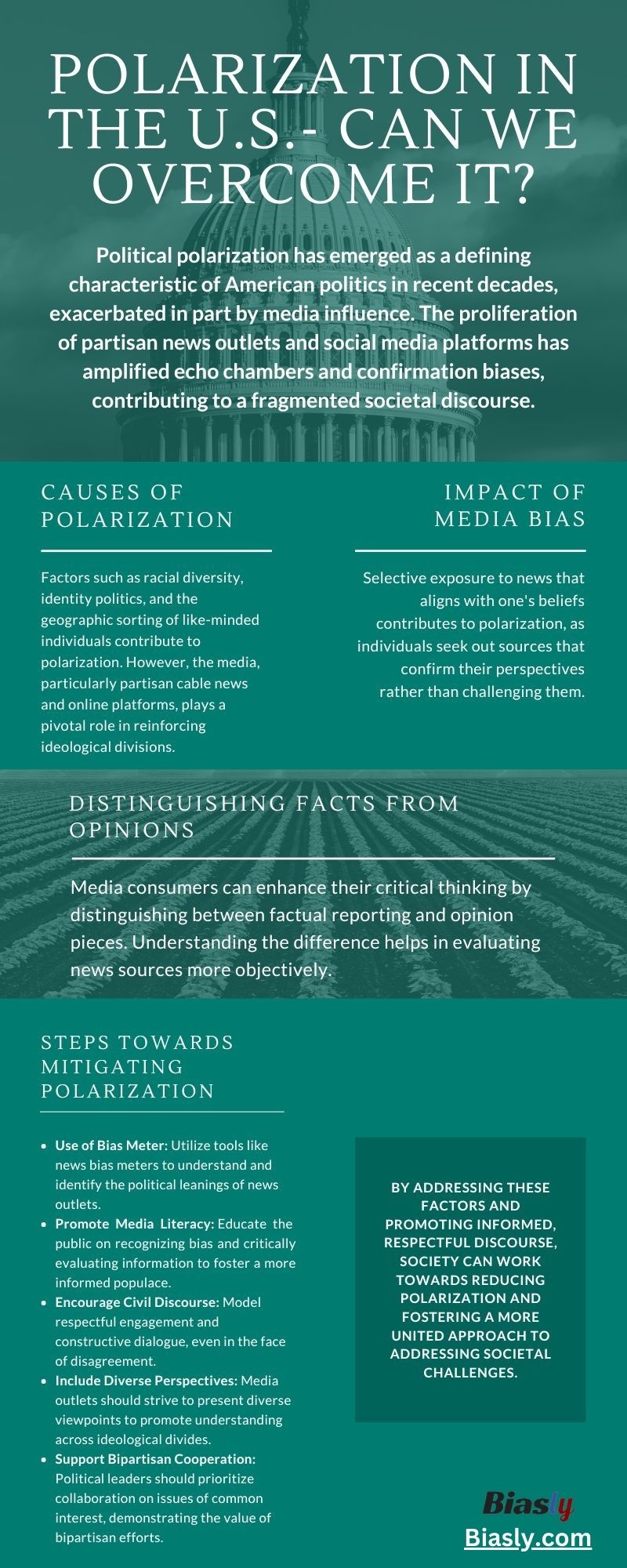
The issue of polarization has become a defining feature of American politics over the last 40 years, with partisan divisions between groups of citizens growing by the year. While it is difficult to pinpoint one specific cause of this hyperpolarized political landscape in America, the media has played a significant role in shaping public opinion and reinforcing ideological biases.
But why is this a problem? Polarization can sometimes be a good thing in democracies. When it becomes extreme, however, citizens start discounting each other’s views, which poses a roadblock to solving societal challenges. Moreover, disregard for those with different beliefs and values sometimes descends into hatred and political violence. As it turns out, conservative and liberal political sites have much to do with our current climate.
What’s Causing Political Polarization?
Polarization occurs for various reasons, including growing racial and religious diversity, identity politics, geographical sorting, and increasing homogeneity within political parties. However, Brown University recently found that the rise of 24-hour partisan cable news and internet coverage is a top contributor to the growing rift in our nation.
The Media’s Contribution to Confirmation Bias and Echo Chambers
The media has become a powerful force on the American political stage and has a major impact on public opinion and the “narrative du jour.” However, in recent years, the media landscape has become polarized, with a proliferation of partisan news outlets and the rise of social media platforms that amplify echo chambers and confirmation biases.
As a result, many Americans are consuming news and information that reinforces their pre-existing beliefs rather than exposing themselves to diverse perspectives and challenging their assumptions; this phenomenon is referred to as “selective exposure.” Essentially, this means that people are seeking out information and news membership from sources that will reinforce their right or left-wing media biases while avoiding information from places that may challenge their ideas.
The media reinforces this behavior by catering to specific ideological and partisan audiences and presenting information in ways consistent with their biases. This selective exposure insulates people from opposing viewpoints and further entrenches them in their beliefs.
Moreover, media outlets and politicians alike have increasingly used divisive rhetoric and engaged in fear-mongering to rally their base and mobilize support. This has created a toxic political environment in which compromise and cooperation are viewed as weaknesses, and political opponents are demonized and dehumanized. Take the following headlines from each side of the political spectrum, for example. Both CNN and Fox used emotionally charged verbiage and villainize the other side, and neither leaves room for the nuance that most certainly exists.
- CNN: The day America realized how dangerous Donald Trump is
- Fox News: The Left’s Constant Covid Power Grab
As the political parties have gotten more and more polarized, so too has our news. News organizations see an opportunity to engage consumers with narratives. These narratives have two components; reporting on political news stories and authors’ opinions about them.
Sources such as Gallup have done polling on US citizens in an attempt to determine how people feel about bias in the news. This poll demonstrated that most people believe that the news has gotten much worse about separating reporting from opinions, and as a result, they’re losing public trust. Bias, fake news, and political leaning are a few of the reasons that many do not trust various news outlets (page 8 of this pdf).
Those who do trust the news, however, tend to believe that their news stations are more trustworthy. A poll conducted on internet users argues that the origin of news is one of the biggest determiners when determining news trustworthiness. This further exacerbates the problem polarization causes, as well as the difficulty in distinguishing between opinion and factual reporting.
Distinguishing Between Facts and Opinions
While there’s not much that individuals can do to change the deep-seated polarization within the American media, they can learn how to distinguish between standard reporting and opinion and become more informed media consumers and better-informed citizens. Honest reporting provides clear, unbiased facts — usually, the who, what, where, why, and how of things. Opinions are the author’s spin on why the reporting is important.
Many of us claim to want unbiased news sources, according to a Pew Research poll, but few of us actually seek them out — and we often need help separating fact from opinion. Maybe this is because it’s difficult to understand the importance of certain events without attaching a narrative to them — or perhaps it’s the absence of unbiased media contributing to the problematic media environment we see today.

Source: Pew Research
Here are a few elements that today’s media consumers can look for to separate facts from polarizing opinions:
| Factual Reporting | Opinion |
| Presents information that can be verified or proven true through evidence or sources | Offers a personal perspective or interpretation of events or issues |
| Focuses on delivering objective information without bias or personal opinions | Uses language that is subjective and may include words like “I believe” or “in my opinion” |
| Provides both sides of an argument or issue, offering multiple perspectives and allowing readers to form their own opinions | May present one side of an argument or issue without presenting alternative viewpoints |
| Includes quotes from experts, witnesses, or individuals directly involved in the event or issue being reported | Often includes personal bias or a point of view that is not necessarily based on fact or evidence |
| Avoids making assumptions or drawing conclusions without evidence to support them | Uses personal observations and opinion to explain or evaluate current events |
| Avoids the use of inflammatory language designed to evoke emotion | Often includes emotional language or appeals to readers’ emotions rather than relying on factual evidence |
It’s important to note that sometimes factual reporting and opinion may be presented together in the same article or news segment. In these cases, it’s crucial to identify where the factual reporting ends and the opinion begins and to consider the source of the opinion and its potential biases. If an author presents their view or argument, that does not mean the news story is unreliable. Be sure to empathize with the author and understand how they came to their conclusion. Fill in more perspectives to try and come to your own conclusion.
Steps Forward to a Less-Polarized Society
So far, we have established that the news has become increasingly biased. We have also determined that the general public has become polarized and views news as untrustworthy based on political leaning. So, what can be done to overcome political polarization and promote a more constructive and collaborative political discourse? Here are some potential solutions:
Use a Bias Meter for News
Using a news bias meter and referring to article bias ratings can be helpful for individuals who want to be more informed about the potential biases of the news sources they consume. By using a news bias meter, people can better understand the political leanings and potential biases of various news outlets and make more informed decisions about the information they consume.
Inspire Media Literacy
A great way to get people out of their echo chambers and rein in polarization is to encourage media literacy, or in other words, educate citizens on identifying political news bias and critically evaluating information. Media literacy exercises can even help make people more aware of the biases they have and open them up to understanding new viewpoints.
Exemplify Civil Discourse
Those who engage with their communities politically or in a leadership capacity can set an example of civility by engaging respectfully with others in constructive discourse, especially when there are disagreements. This involves avoiding demonization, divisive rhetoric, and name-calling.
Promote Diverse Perspectives
Media outlets have a large part to play in reducing polarization and changing the tone of American politics. Every outlet should strive to voice perspectives and feature opinions from across the political spectrum rather than catering only to one side of the aisle.
Foster Bipartisan Cooperation
U.S. political leaders must also set the tone for the discourse by modeling the importance of bipartisanship. They should be seeking opportunities to compromise and collaborate on issues with broad support across the spectrum, working toward solutions that benefit all Americans.
Final Word
Political polarization in the United States is a complex and multifaceted issue, but the media has undoubtedly played a significant role in shaping public opinion and reinforcing ideological biases. By promoting media literacy, encouraging diverse perspectives, fostering civil discourse, and promoting bipartisan cooperation, we can begin to overcome this polarization and build a more collaborative and constructive political discourse for a brighter future.























